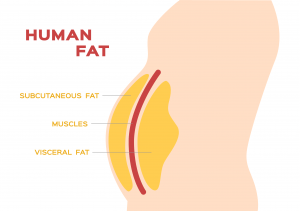
Usually, belly fat is subcutaneous fat, which is underneath the skin. If you have problems with abdominal fat, it may also be visceral fat. This is also known as organ fat that is packed between your internal organs. This is also known as the “pot belly” or the “beer belly.” It is associated with type 2 diabetes, cardiovascular disease, and colorectal cancer.
For women, belly fat is more common after menopause. Sometimes, those people who just think this goes hand-in-hand with getting older, and don’t realize the danger it can cause. While women feel like it is just something that makes them go up a size in their jeans, it does carry health risks.
Like fat in any other area, it is determined by balancing your calories you take in with the energy you burn. In other words, if you eat too much and burn too little, you’ll have excess fat. As you get older, your muscle mass reduces. Your fat, however, increases. When your muscle mass reduces, it also reduces the rate your body uses calories. This can make it even more difficult for people to maintain a weight that is healthy as they age.
Sometimes, you can have an increase of belly fat as you age without even gaining weight. In women, this can be due to a reduced level of estrogen. Research has shown that estrogen seems to influence where the fat is distributed in a woman’s body. Regardless of a weight shown as normal on the BMI measurement charts, women with a large waistline have been known to carry the risk of premature death and often dye earlier of cardiovascular disease.
Most women hate to even have an inch or so too much belly fat. How do you know, however, if the belly fat you carry is a health risk? Just measure it. Use a tape measure and place it around your bare stomach. You want it to be snug, but not cut into the skin. For women, if your measurement is over 35 inches, you’ll be at a greater risk for health problems. For men, the measurement of concern is around 40 inches.
People who are plagued with belly fat often exercise and participate in healthy activities, yet they still retain that unwanted fat. It seems like the fat is immune to exercise. So how do you get rid of it? What is the magic combination that says “poof” to that extra poundage? It depends on your sex, age, and the amount of pounds you want to lose, but there are many tips to help you reduce that unwanted belly fat.

